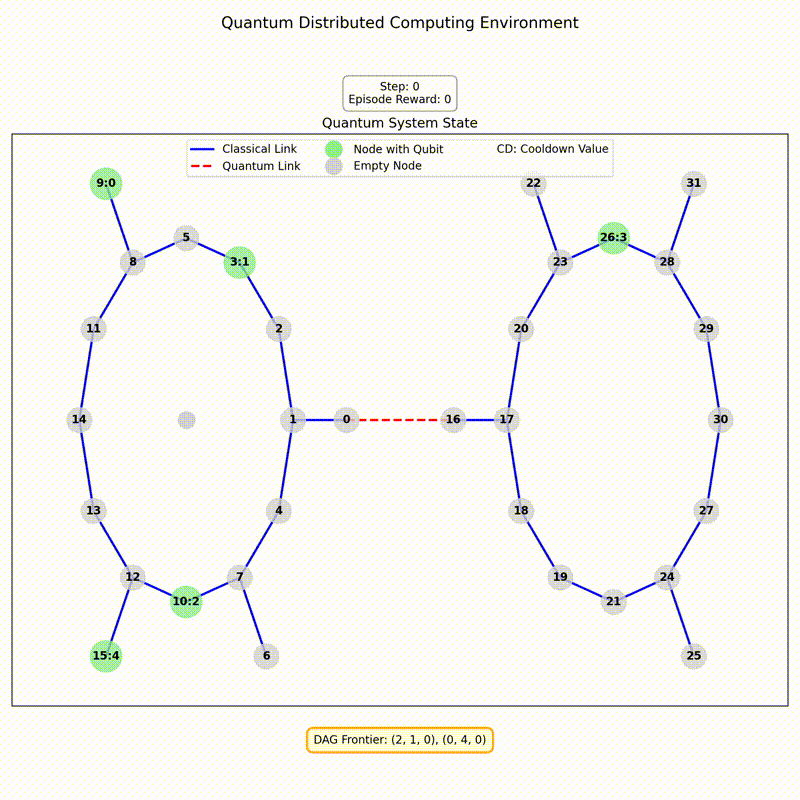Optimizing and Modeling Quantum Entanglement Distribution Networks
Quantum networks distribute high-fidelity entanglement between distant users to enable secure communication, distributed sensing, and distributed quantum computing. In lossy optical channels, however, the success probability of each entanglement-generation attempt decays exponentially with distance. To overcome this, networks rely on intermediary nodes—such as quantum repeaters and quantum switches—that perform entanglement swapping to connect non-adjacent users.
As we move from simple linear repeater chains to multi-user star and mesh topologies, the core challenge shifts from physical-layer noise management along a single path to network-layer scheduling, routing, and resource allocation across many competing user pairs. A quantum network receives requests for end-to-end entanglement between distant users while probabilistic link-level entanglement generation produces Bell pairs between neighbors that must be stored in noisy memories and consumed through entanglement swaps before decoherence destroys them.
My research develops analytical models and control algorithms for these quantum switches and entanglement networks. I study how to exploit limited, imperfect quantum memories to maximize entanglement rates under fidelity constraints, characterize the throughput and fidelity regions of quantum switches, and design scheduling and routing policies that fully utilize scarce resources. These results provide design guidelines for future architectures and control planes in large-scale or near-term quantum networks.
Selected Publications
Promponas, P., Valls, V., Guha, S., & Tassiulas, L. (2024). Maximizing entanglement rates via efficient memory management in flexible quantum switches. IEEE Journal on Selected Areas in Communications, 42(7), 1749–1762.
Promponas, P., Valls, V., & Tassiulas, L. (2023, June). Full exploitation of limited memory in quantum entanglement switching. In 2023 IFIP Networking Conference (IFIP Networking) (pp. 1–9). IEEE.
Valls, V., Promponas, P., & Tassiulas, L. (2024). A Brief Introduction to Quantum Network Control. IEEE Communications Magazine, 62(10), 48–53.
Valls, V., Promponas, P., & Tassiulas, L. (2023). On the capacity of the quantum switch with and without entanglement decoherence. IEEE Communications Letters, 27(9), 2388–2392.
Distributed Quantum Computing and Compiler Design
As quantum computing technology evolves, a single quantum processor may not be able to handle the size and complexity of large-scale quantum applications. To address this, Distributed Quantum Computing (DQC) has emerged as a promising architecture that connects multiple quantum processors via quantum links to operate as a unified computational platform.
One of the core challenges in DQC is enabling seamless execution of quantum circuits across physically separated QPUs. This requires careful handling of two critical compilation tasks:
- Initial Qubit Mapping: Strategically assigning logical qubits in the circuit to the physical qubits available across the networked QPUs, in a way that anticipates and minimizes costly inter-QPU operations.
- Qubit Routing: Managing the generation and use of entanglement links, scheduling quantum teleportation operations, and injecting SWAP gates to move qubits efficiently across and within QPUs.
Our work is focused on developing compilation frameworks that jointly consider these aspects under realistic system constraints, such as limited link fidelity, qubit decoherence, and network congestion. The goal is to enable efficient, scalable, and reliable execution of quantum circuits in distributed settings.
The GIF below demonstrates a scenario with two QPUs connected by a single quantum link. It visualizes some of the actions that the compiler can perform: locally SWAPping logical qubits within a QPU, and performing qubit and gate teleportations across QPUs. These actions are taken to execute a quantum circuit, which is represented internally as a Directed Acyclic Graph (DAG).

Selected Publications
Promponas, P., Mudvari, A., Della Chiesa, L., Polakos, P., Samuel, L., & Tassiulas, L. Compiler for Distributed Quantum Computing: a Reinforcement Learning Approach. 2025 IEEE International Conference on Communications (ICC ‘25).
Crampton, O., Promponas, P., Chen, R., Polakos, P., Tassiulas, L., & Samuel, L. (2024). A Genetic Approach to Minimising Gate and Qubit Teleportations for Multi-Processor Quantum Circuit Distribution. arXiv preprint arXiv:2405.05875.